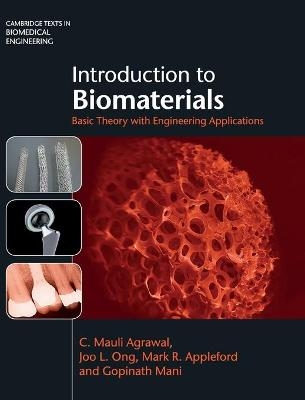
Introduction to Biomaterials
Cambridge University Press (Verlag)
978-0-521-11690-9 (ISBN)
This succinct textbook gives students the perfect introduction to the world of biomaterials, linking the fundamental properties of metals, polymers, ceramics and natural biomaterials to the unique advantages and limitations surrounding their biomedical applications. Clinical concerns such as sterilization, surface modification, cell-biomaterial interactions, drug delivery systems and tissue engineering are discussed in detail, giving students practical insight into the real-world challenges associated with biomaterials engineering; key definitions, equations and concepts are concisely summarised alongside the text, allowing students to quickly and easily identify the most important information; and bringing together elements from across the book, the final chapter discusses modern commercial implants, challenging students to consider future industrial possibilities. Concise enough to be taught in a single semester, and requiring only a basic understanding of biology, this balanced and accessible textbook is the ideal introduction to biomaterials for students of engineering and materials science.
C. M. Agrawal is the Vice President for Research at the University of Texas at San Antonio, and the Peter Flawn Professor of Biomedical Engineering, specializing in orthopaedic and cardiovascular biomaterials and implants. He is a member of the International College of Fellows of Biomaterials Science and Engineering, a Fellow of the American Institute for Medical and Biological Engineering, a former President of the Society for Biomaterials, and was awarded the 2010 Julio Palmaz Award for Innovation in Healthcare and the Biosciences. J. L. Ong is Chair of the Department of Biomedical Engineering and the USAA Foundation Distinguished Professor at the University of Texas, San Antonio, where his research focuses on modification and characterization of biomaterials surfaces for dental and orthopaedic applications, tissue engineering ceramic scaffolds, protein-biomaterial interactions and bone-biomaterial interactions. He is a Fellow of the American Institute for Medical and Biological Engineering. Mark Appleford is an Assistant Professor of Biomedical Engineering at the University of Texas, San Antonio, focusing on tissue-biomaterial interactions, cellular engineering, reconstructive tissue engineering, and biocompatibility. Gopinath Mani is an Assistant Professor of Biomedical Engineering at the University of South Dakota, focusing on surface modification and characterization of biomaterials, nanomaterials and nanomedicine, biodegradable metals and drug delivery systems. He is the Program Chair for the Surface Characterization and Modification Special Interest Group of the Society for Biomaterials, and has developed and taught numerous graduate-level programs in biomaterials engineering.
1. Introduction; 2. Basic properties of materials; 3. Biological systems; 4. Characterization of biomaterials; 5. Metals: structure and properties; 6. Polymers; 7. Ceramics; 8. Natural biomaterials; 9. Surface modification; 10. Sterilization of biomedical implants; 11. Cell-biomaterial interactions; 12. Drug delivery systems; 13. Tissue engineering; 14. Clinical applications.
| Erscheint lt. Verlag | 7.11.2013 |
|---|---|
| Reihe/Serie | Cambridge Texts in Biomedical Engineering |
| Zusatzinfo | Worked examples or Exercises; 100 Halftones, unspecified; 138 Line drawings, unspecified |
| Verlagsort | Cambridge |
| Sprache | englisch |
| Maße | 196 x 249 mm |
| Gewicht | 1060 g |
| Themenwelt | Medizin / Pharmazie ► Medizinische Fachgebiete ► Biomedizin |
| Medizin / Pharmazie ► Physiotherapie / Ergotherapie ► Orthopädie | |
| Naturwissenschaften ► Biologie ► Biochemie | |
| Naturwissenschaften ► Biologie ► Genetik / Molekularbiologie | |
| Naturwissenschaften ► Biologie ► Humanbiologie | |
| Naturwissenschaften ► Biologie ► Zellbiologie | |
| Technik ► Maschinenbau | |
| Technik ► Medizintechnik | |
| Technik ► Umwelttechnik / Biotechnologie | |
| ISBN-10 | 0-521-11690-2 / 0521116902 |
| ISBN-13 | 978-0-521-11690-9 / 9780521116909 |
| Zustand | Neuware |
| Informationen gemäß Produktsicherheitsverordnung (GPSR) | |
| Haben Sie eine Frage zum Produkt? |
aus dem Bereich


